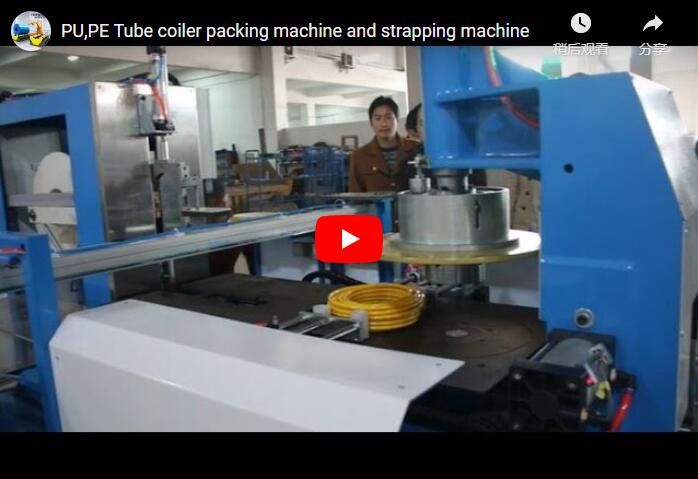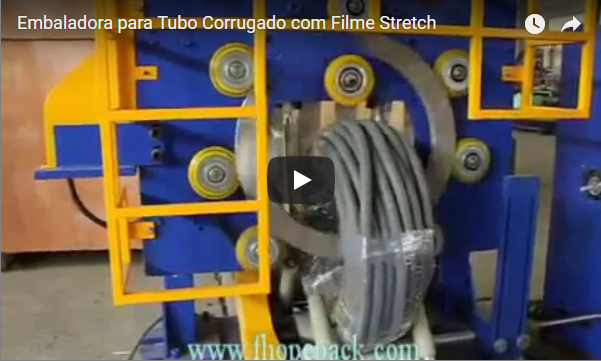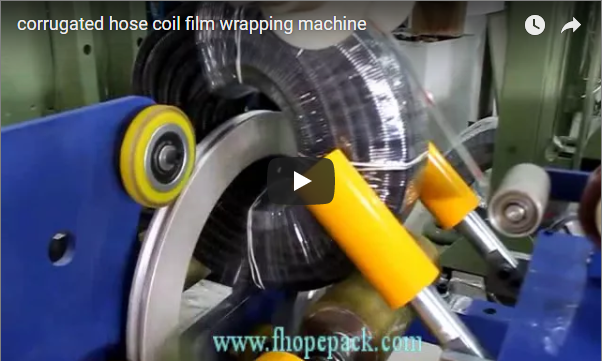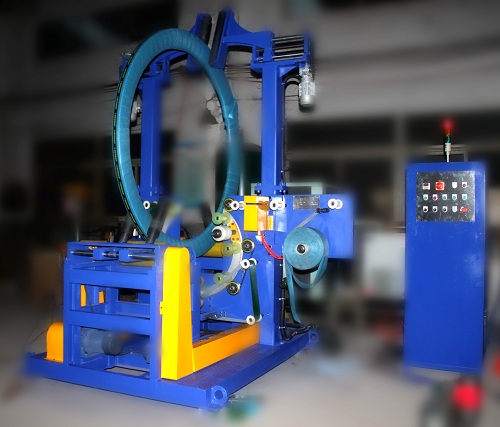Mastering Coil Protection: The Horizontal Wrapping Machine with Movable Station
In the demanding environments of steel, aluminum, and wire processing industries, safeguarding large-diameter, heavy coils during storage and transit is paramount. Damage from moisture, dust, corrosion, or handling mishaps can lead to significant material loss and customer dissatisfaction. Enter the horizontal coil wrapping machine, a specialized automated solution engineered for robust and efficient coil packaging. This article delves into the technology, benefits, and operational considerations of a specific configuration: the horizontal wrapper featuring a movable wrapping station, aligning with the practical focus often found in The Fabricator magazine.
Such automated systems represent a significant leap from manual or semi-automated methods, addressing critical industry needs for consistency, throughput, and worker safety. Research consistently highlights the vulnerability of metal coils to environmental factors, with studies like those published in materials science journals emphasizing the need for barrier packaging, often achieved effectively with stretch film applied by machines like these. Furthermore, patents related to orbital wrapping technology often focus on optimizing film tension (e.g., US Patent X,XXX,XXX describing dynamic tension control) and improving the mechanics of the wrapping ring or shuttle for higher speeds and reliability – features central to modern horizontal wrappers.
Understanding the Horizontal Coil Wrapper Technology
A horizontal coil wrapping machine operates on an orbital wrapping principle. The coil rests on support rollers or conveyors, and a wrapping ring or shuttle carrying the packaging material (typically LLDPE stretch film, VCI film, or paper) rotates through the eye of the coil and around its outer circumference. This method ensures complete encapsulation and tight, secure packaging.
The Advantage of the Movable Wrapping Station
The key innovation highlighted here is the movable wrapping station. Unlike fixed stations, this design allows the entire wrapping unit (including the ring/shuttle, film carriage, and associated mechanisms) to traverse along a track. This offers several distinct advantages:
- Integration Flexibility: Easily integrates into existing production lines or complex layouts where coil positioning might vary. It can be positioned optimally relative to upstream payoff reels or downstream conveyors.
- Space Optimization: Can service multiple coil preparation or exit points without requiring dedicated wrappers at each location, potentially reducing the overall footprint.
- Enhanced Accessibility: Simplifies loading and unloading procedures, especially for oversized or awkwardly positioned coils.
- Process Flow Improvement: Allows for sequential operations, such as banding or labeling, to occur nearby while the wrapping station moves to the next coil, potentially improving overall line efficiency.
This specific configuration, the Big coil wrapping machine horizontal type with a movable station, is particularly suited for operations handling a variety of coil sizes or requiring adaptable line configurations.
Core Operational Parameters and Capabilities
Modern horizontal coil wrappers are engineered for demanding industrial use. Key parameters typically include:
- Coil Specifications:
- Outer Diameter (OD): Ranges typically accommodate coils from 500mm up to 2500mm or more.
- Inner Diameter (ID): Minimum ID often around 400mm, depending on ring size.
- Width: Can handle widths from 100mm to over 1000mm.
- Weight: Capacities range from a few hundred kilograms to over 10,000 kg, requiring robust frame and roller construction.
- Wrapping Materials:
- LLDPE Stretch Film: Most common, providing load stability and environmental protection.
- VCI (Volatile Corrosion Inhibitor) Film: Offers enhanced corrosion protection for sensitive metals.
- Kraft Paper / Woven Materials: Used for specific surface protection or absorbency needs.
- Performance Metrics:
- Wrapping Speed: Ring rotation speeds can range from 30 to 90 RPM, influencing cycle time.
- Film Overlap: Adjustable, typically from 25% to 75%, allowing control over protection level and material consumption.
- Cycle Time: Dependent on coil size, desired wraps, and machine speed, but significantly faster than manual methods.
- Control Systems:
- PLC (Programmable Logic Controller): Provides reliable automation and control over all machine functions.
- HMI (Human-Machine Interface): Touchscreen panels for easy operation, parameter adjustments, recipe storage, and diagnostics.
- Sensors: Photo-eyes and proximity sensors for detecting coil presence, position, and ensuring safe operation.
Key Features Driving Efficiency and Return on Investment
Beyond the core wrapping function, several features contribute significantly to the value proposition of advanced horizontal wrappers:
- Powered Pre-stretch Film Carriage: This is critical. By stretching the film (often up to 300%) before application, it maximizes film yield, reduces material costs significantly (as highlighted in packaging industry reports), and provides superior load containment with less material.
- Automatic Film Clamp, Cut, and Wipe System: Eliminates manual intervention at the start and end of cycles, speeding up the process and improving consistency.
- Variable Overlap Control: Allows operators to apply more or less material precisely where needed (e.g., extra layers on the coil edges).
- Corner/Edge Protection Applicators: Optional devices that automatically place cardboard or plastic edge protectors before wrapping, preventing damage from strapping or handling.
- Integrated Conveying Systems: Roller or chain conveyors automate the transport of coils into and out of the wrapping station, enabling fully in-line operation.
- Robust Safety Systems: Light curtains, safety interlocks on access doors, emergency stops, and physical guarding are essential for operator protection, meeting stringent industrial safety standards (e.g., ANSI/PMMI B155.1).
- Data Logging & Connectivity: Modern machines may offer IoT capabilities for remote monitoring, performance tracking, and integration with plant-wide Manufacturing Execution Systems (MES) or Enterprise Resource Planning (ERP) systems.
Analyzing the Investment: Beyond the Initial Cost
While a fully automatic horizontal coil wrapper, especially one with a movable station, represents a significant capital investment (often ranging from $30,000 to well over $100,000 depending on size and features), a proper cost-benefit analysis reveals substantial long-term returns:
- Labor Reduction: A single automated wrapper can often perform the work of multiple employees engaged in manual wrapping, drastically cutting direct labor costs and freeing up personnel for higher-value tasks.
- Material Savings: The efficiency of powered pre-stretch systems can reduce stretch film consumption by 50% or more compared to manual or basic machine wrapping. Consistent application eliminates waste from uneven wraps.
- Damage Reduction: Uniform, tight wrapping provides superior protection against transit and storage damage, minimizing costly returns, rework, or scrap. This directly impacts the bottom line and customer satisfaction.
- Increased Throughput: Automated cycles are significantly faster and more consistent than manual methods, increasing the number of coils that can be processed per shift and reducing bottlenecks.
- Enhanced Safety: Automating the handling and wrapping of heavy, potentially sharp-edged coils minimizes risks of strains, cuts, and other manual handling injuries, reducing potential worker compensation claims and downtime.
- Improved Load Stability: Properly tensioned and overlapped film ensures coils are stable units, crucial for safe stacking, storage, and transportation.
Choosing the Right Horizontal Wrapping Solution
Selecting the optimal machine requires careful consideration of specific operational needs:
- Production Volume & Speed: Match the machine's cycle time and throughput capabilities to your line requirements. High-volume operations necessitate fully automatic systems.
- Coil Characteristics: Ensure the machine's specifications (OD, ID, width, weight capacity) comfortably exceed your largest and heaviest coils.
- Line Layout & Flexibility: Assess if a fixed or movable wrapping station better suits your floor plan and process flow. Consider future expansion needs.
- Required Protection Level: Determine if standard stretch film is sufficient or if VCI films or additional edge protection are needed, ensuring the machine can handle these options.
- Budget & ROI Calculation: Analyze the Total Cost of Ownership (TCO), factoring in initial price, installation, materials, energy, maintenance, and expected savings in labor and damage reduction.
- Supplier Reliability & Support: Choose a reputable manufacturer offering robust construction, comprehensive warranties, readily available spare parts, and responsive technical support.
Conclusion: Investing in Coil Integrity and Efficiency
The horizontal coil wrapping machine with a movable wrapping station represents a sophisticated solution tailored to the rigorous demands of the metals and wire industries. By automating the packaging process, it delivers tangible benefits in productivity, material efficiency, product protection, and worker safety. While the initial investment is substantial, the long-term savings derived from reduced labor, material waste, and product damage often provide a compelling return on investment. As highlighted in publications like The Fabricator, embracing automation technologies like advanced coil wrappers is key to maintaining competitiveness, ensuring product quality, and achieving operational excellence in modern manufacturing and processing environments. This technology is not just about wrapping coils; it's about preserving value and streamlining logistics from the production line to the end customer.






